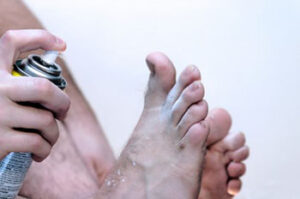
It is a fungal infection on feet. A Fungus is a microscopic organism that thrives in warm and damp environments. Fungal infections to the skin are known as tinea infections, and the fungus growing on the feet is known as tinea pedis or athlete’s foot; the name is from the fact that it affects people whose feet are always sweaty and damp. The fungal infection is caused by trichophyton found in clothing and on floors.
Signs and Symptoms
It affects the skin between the toes. You may experience the sensation of burning, stinging, and itchy. The skin may also become flaky, dry, scaly, red, and may crack.
Where the skin cracks, you may notice swelling, itchy blisters, or oozing. The side of the foot or the sole may also develop scaling patterns.
Due to the skin cracking and causing severe open sores, the feet are now vulnerable to bacterial infections. Bacterial infections can occur alongside the condition.
If left untreated for long, you risk the infection from spreading from toe to toe, and in rare cases, it spreads to the hands. Ensure you wash your hands thoroughly with soap and water after touching the affected area. When you touch the infected area and touch other parts of the body you risk spreading the infections to other parts.
You may notice a rash at the bottom and on the sides of the feet.
What to do for prevention and treatment
Continue using the pharmacy treatments to stop the condition from coming back.
Keep your feet clean and dry.
As you are washing your feet, ensure you wash between the toes and dry by dabbing rather than rubbing.
Set aside a towel for your feet and ensure it is washed regularly. Do not share the towel with other people.
Wear clean cotton socks daily, and change the pair of shoes every two days if possible.
When you are at home, take off your shoes. In public showers and changing rooms avoid walking barefooted.
Wear comfortable shoes with breathable material and if you notice the shoes make your feet sweaty and hot, avoid them.
NOTE: These tips will keep the athlete’s foot from coming back if you continue following them.
Is it contagious?
Yes, the condition spreads when you touch an affected area and touch other areas. It also spreads through sharing of towels, socks, and shoes with an infected person. Walking barefoot in damp environments, like pool areas or public showers, where the fungus thrives could also cause the infection.
Diagnosis
This can be done by observation. The doctor will observe the symptoms and signs common with athlete’s foot infection. However, the podiatrist might rule out other conditions such as low-grade skin infection by conducting a test known as skin lesion potassium hydroxide. The doctor takes a sample of the infected tissue and uses the potassium hydroxide to destroy the human cells and leave the fungal cells, only seen under a microscope.
When to contact a podiatrist
Most of the time, the symptoms are mild, and there is no need to see a doctor. However, you should see a podiatrist if
- The over-the-counter treatments do not work.
- If you experience discomfort.
- If the foot is painful, red, and hot, it could be a more serious infection.
- If you have diabetes it could make the condition more complicated.
- If you have had an organ transplant or undergoing chemotherapy, your immune system is weakened and you need more care.
Athlete’s foot can be an uncomfortable condition to live with. For more information, contact Dr. Ejodamen Shobowale of DeNiel Foot & Ankle Center. Our doctor will answer any of your foot- and ankle-related questions.
Related Posts
No related posts.
Comments
[…] burning, and stinging between the toes and on the soles of the feet are classic symptoms of athlete’s foot. Moreover, the affected skin may be red, scaly, and broken. In severe cases, blisters and thickened […]